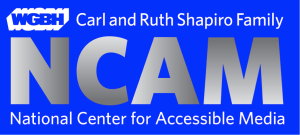Introduction | Getting Started | Table of Contents | Copyright Statement | Download Microsoft Word Document
Introduction
These image description guidelines were developed by the Carl and Ruth Shapiro Family National Center for Accessible Media at WGBH (NCAM) in conjunction with the DIAGRAM Center (Digital Image And Graphic Resources for Accessible Materials) at Benetech. The DIAGRAM Center is a research and development center whose goal is to make it easier, cheaper, and faster to create and use accessible digital images. Established in 2010, the DIAGRAM Center is a Benetech Global Literacy initiative supported by the U.S. Department of Education, Office of Special Education Programs. Through a series of grants funded by the National Science Foundation and the US Department of Education, NCAM has been researching and developing methods for creating effective and efficient text alternatives to images so that kids and adults, students and professionals, who are blind or have low vision can have equal access to image-rich digital texts. Beginning in 2004, under a grant from the National Science Foundation, NCAM began research into refining description approaches for images found in science, technology, engineering, and mathematics (STEM) texts. NCAM and its project partners reviewed hundreds of descriptions and numerous image types, eventually narrowing their focus to the most commonly used images in STEM. This research included rounds of surveys with blind and low vision STEM professionals (scientists, mathematicians, etc.) and user-testing with higher education students with visual impairments. The result was a set of guidelines and training materials for image description that encourage recommended practices such as brevity, focus on data, clarity and consistency in language, navigation control via accessible lists, tables, and the proper use of headers. In late 2012, the DIAGRAM Center launched the Poet Image Description Tool – an open-source, web-based tool facilitating the production of accessible images. To date, over 45,000 image descriptions have been created using Poet, but feedback from early adopters and partners unearthed significant challenges related to writing descriptions. In response, NCAM and DIAGRAM teamed up in the fall of 2014 to provide additional references to support those looking to make images accessible. The pages that follow extend beyond the initial research and guidelines started by NCAM roughly a decade ago. General best practices that apply to all types of images have been added as well as an expanded set of image-specific recommendations. The expanded recommendations include image types frequently found in the humanities and social sciences, such as maps, photographs, and art. We are excited to share this resource and would like to acknowledge the DIAGRAM community and Poet supporters for their input throughout this project. Special thanks to the dozens of “image slam” and “describathon” volunteers who provided invaluable feedback, and without whom, this reference guide would not have been possible. We hope this reference will be helpful to all of you and others still learning about image accessibility.

Getting Started
This reference document is broken into two main sections. The first section details best practices concerning style, language, formatting, and layout that apply to every type of image. More specifically, this includes consideration of key elements such as context, audience, and function, as well as the use of appropriate tone. This section also introduces layout considerations that are commonly encountered across a variety of images such as insets and images that span multiple pages. In addition, frequently asked questions by new describers such as when to mention color and how to describe emotions are addressed in this portion of the document.The second section of this document presents best practices that are specific to particular image categories and classifications. The best approach for describing a line graph is different from the best approach for describing a map. Describers are faced with different kinds of challenges and questions because creating an accessible description differs greatly depending on the type of image. Therefore, this section aims to present the nuances specific to types of images.
This reference guide has been formatted as an HTML resource on this site, but is also available for direct downloaded as a Word Document.
Please feel free to send us your feedback on this resource by using the Contact Us form.
Table of Contents
I. General Image Description Guidelines:
A. Style and Language
B. Formatting & Layout
II. Specific Image Description Guidelines:
A. Art, Photos & Cartoons
B. Chemistry
C. Diagrams: Illustrated
D. Diagrams: Relational
E. Graphs
F. Maps
G. Mathematics
H. Tables
I. Text Only Images
Return to top of page | Copyright Statement | Download Microsoft Word Document | Next: Go to Part 1 (General Guidelines)

